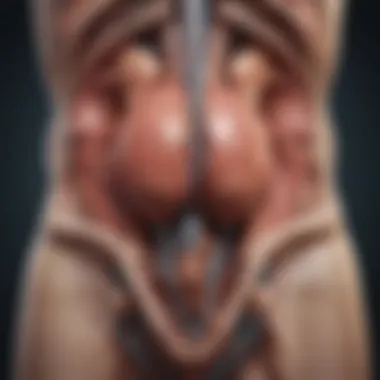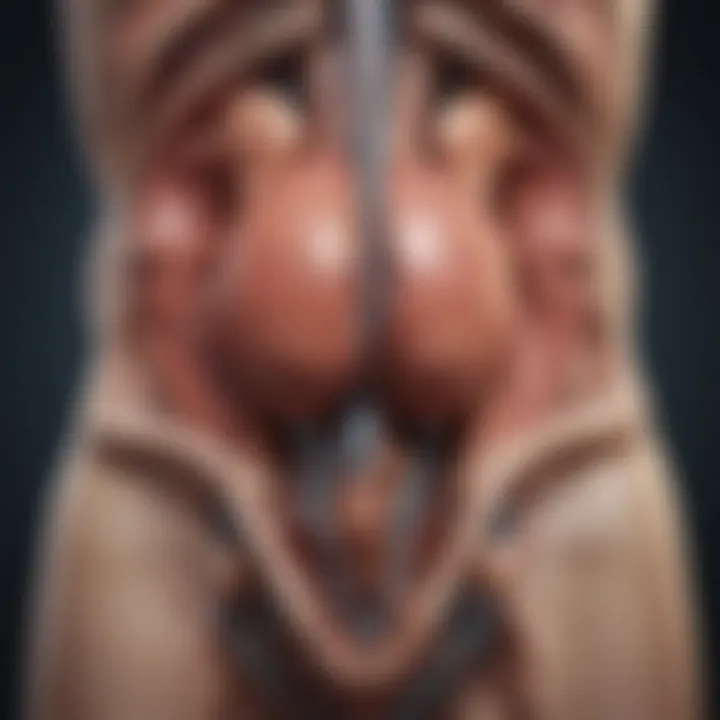Understanding Urinary Retention: Causes and Management


Intro
Urinary retention is more than just a clinical inconvenience; it carries significant implications for both physical health and psychological well-being. The inability to voluntarily urinate can lead to physical strain, emotional distress, and complications that may extend beyond the urinary system itself. Whether acute or chronic, this condition requires a nuanced understanding that encompasses a myriad of potential contributing factors.
Every individual’s experience with urinary retention can differ widely, influenced by various medical, lifestyle, and psychological factors. Physicians often encounter patients who exhibit urinary retention due to acute situations—like infections or medication side effects—while others may grapple with chronic forms, often stemming from underlying neurological conditions or structural abnormalities.
As we navigate through the intricacies of urinary retention, we will dissect how these contributing elements intertwine and shape treatment plans. This article emphasizes the importance of education among patients and health professionals alike, aiming to establish a foundation for informed discussions around symptoms, diagnosis, and practical management strategies.
Through a thorough exploration of this topic, we shall provide clarity on the multifaceted approaches required for effective intervention, thus facilitating better outcomes for those affected by this condition.
Prelude to Urinary Retention
Urinary retention is a topic that requires our attention, given its potential disruption to daily life and its implications for long-term health. Understanding this condition involves more than just knowing what it is; it's about grasping its complexities, its underlying causes, and the myriad ways it can affect individuals both physically and emotionally. When we dig into urinary retention, we uncover a range of factors that can contribute, from anatomical abnormalities to psychological barriers.
By examining urinary retention in depth, we can better appreciate the nuances of this phenomenon. This understanding not only benefits healthcare professionals in diagnosing and treating patients effectively but also equips individuals with the knowledge to recognize symptoms and seek help when needed.
Definition and Overview
Urinary retention can be defined as the inability to completely empty the bladder. This might manifest in two forms: acute or chronic. In acute cases, a person can suddenly find themselves unable to urinate, which can lead to significant discomfort and require immediate medical intervention. Chronic urinary retention, on the other hand, develops gradually. Patients might be able to urinate somewhat, but not fully, leading to lingering issues like frequent urination, urgency, or even urinary incontinence due to overflow.
This condition could result from a variety of causes including obstructions, nerve problems, and even certain medications that impact bladder function. Thus, knowing this definition sets the stage for understanding its various facets and consequences in life.
Prevalence and Significance
The occurrence of urinary retention isn’t as rare as one might think. While it can affect individuals at any age, its prevalence increases significantly in older adults, particularly due to conditions like benign prostatic hyperplasia in men or pelvic disorders in women. According to various studies, the rates of acute urinary retention in older populations can range from 30 to 50 percent, reflecting a significant public health concern.
Moreover, urinary retention can affect the quality of life profoundly. Individuals may experience sleep disturbances due to increased nighttime urination or embarrassment from accidents in social situations. For many, the fear of incontinence becomes a psychological burden that can inhibit social interactions and lead to isolation. Given these implications, it becomes clearer why this topic holds relevance for healthcare providers, caregivers, and affected individuals alike.
"Awareness is the first step to addressing urinary retention, as many individuals suffer in silence, unsure of how to find relief and regain control."
In summary, urinary retention is not merely a bodily malfunction; it intertwines with numerous social, psychological, and medical aspects. The information presented here serves as groundwork for further discussion on the causes, implications, features, and management strategies related to this condition.
Physiology of Urination
Understanding the physiology of urination is crucial in grasping the complexities of urinary retention. It lays the groundwork for recognizing how normal functions can become disrupted, leading to various clinical scenarios. The coordination between the bladder, sphincters, and nervous system is a finely tuned process that illustrates the intricacies of human biology. Disruptions in this system can lead to significant distress and other complications, making it imperative to have a firm understanding of these processes.
Normal Urinary Functioning
Normal urinary functioning involves a series of well-orchestrated events that permit the body to eliminate waste efficiently and effectively.
- Filling Phase: As the bladder fills with urine produced by the kidneys, stretch receptors in the bladder wall are activated. This sends signals to the brain, creating the sensation of fullness. During this phase, the internal urethral sphincter remains contracted to prevent involuntary leakage.
- Voiding Phase: When the bladder reaches a certain level of fullness, the brain signals for the appropriate muscle contractions. The detrusor muscle contracts and the internal sphincter relaxes, allowing urine to flow into the urethra. A well-functioning external sphincter gives control over the timing of urination, allowing for voluntary release.
These phases are not merely mechanical; they are intensely regulated by neural pathways that integrate both spinal and cortical signals. This coordination is essential for healthy bladder function and highlights how delicate the balance is.
"An efficient bladder is like a well-oiled machine, where every component operates in harmony."
Neuroanatomy of the Urinary System
Delving into the neuroanatomy of the urinary system reveals the intricate networks that play a role in urination. Primarily, the brain, spinal cord, and peripheral nerves collaborate to control bladder functions.
- Central Nervous System: The brain, especially the pontine micturition center, regulates the reflexive and voluntary aspects of urination. It processes sensory information and permits conscious control over voiding.
- Spinal Cord: The sacral spinal cord houses neurons responsible for bladder contraction. These neurons are critical in relaying information between the bladder and the brain.
- Peripheral Nerves: The parasympathetic nerves stimulate contractions of the bladder, whereas the sympathetic nerves inhibit urination, illustrating a push-pull mechanism in bladder control.
Even slight dysfunction in these areas can lead to conditions like urinary retention or incontinence, illuminating the fragility of this system. Understanding this anatomy helps researchers and practitioners orient their management strategies accordingly, paving the way for a more targeted approach to urinary issues.
In summary, the physiology of urination encompasses far-reaching implications that extend beyond mere botanical functions. It offers insight into the possible disruptions that can lead to conditions like urinary retention, underlining the importance of both a sound anatomical knowledge and a robust understanding of physiological processes.
Types of Urinary Retention
Understanding the distinct types of urinary retention is essential for both diagnosis and treatment. By categorizing urinary retention into acute and chronic forms, healthcare professionals can tailor their approach based on the underlying causes and the urgency of the situation. This section will outline these types, illustrating their characteristics and implications.
Acute Urinary Retention
Acute urinary retention typically appears suddenly and often requires immediate medical attention. This condition can be truly alarming for the affected individual, as it signifies an abrupt inability to void urine despite a full bladder. The causes of acute urinary retention can vary widely, from obstructive factors like benign prostatic hyperplasia to neurological issues or even an adverse drug reaction.
Some key aspects of acute urinary retention include:
- Emergency Response: This situation is often classified as a medical emergency. Failure to treat can lead to severe complications like bladder damage or renal failure.
- Symptoms: Patients usually experience a sudden onset of severe discomfort or pain in the lower abdomen, coupled with a compelling urge to urinate.
- Diagnostic Approach: Quick assessment often relies on physical examinations along with imaging tests, which may include an ultrasound to assess bladder distension.
Ultimately, timely intervention is crucial. According to studies, proper management of acute urinary retention not only resolves immediate discomfort but also reduces the risk of chronic issues later.
Chronic Urinary Retention
In contrast to its acute counterpart, chronic urinary retention develops more insidiously, often over months or even years. Patients may not realize they have a problem until they encounter significant complications, as some might adapt to a urinary pattern that includes frequent voiding with only small amounts of urine expelled. Chronic urinary retention can stem from a variety of causes, primarily mechanical obstruction or nerve dysfunction.
Consider the following aspects of chronic urinary retention:
- Gradual Onset: Symptoms may include urinary frequency, urgency, and incomplete bladder emptying. Unlike acute cases, these symptoms might be overlooked or minimized by patients.
- Diagnostic Complexity: Diagnosis may involve detailed assessments including urodynamic studies and cystoscopy to understand the underlying issues fully.
- Management Variability: Treatment options can vary widely, ranging from lifestyle changes and medication to surgical interventions, depending on the severity and cause of the retention.
Understanding the differences between acute and chronic urinary retention is critical, as this knowledge directly influences management strategies and overall patient outcomes.
In sum, recognizing these types of urinary retention enhances understanding and promotes more effective treatment options, ultimately fostering better health outcomes for patients. Discerning between acute and chronic retention lays the foundation for tailored interventions, underscoring the importance of this differentiation in clinical practice.
Common Causes of Urinary Retention


Understanding the common causes of urinary retention is crucial as it sheds light on why certain individuals may find themselves in distressing situations. This knowledge empowers healthcare providers and patients alike to discern potential underlying issues, allowing for timely intervention and tailored treatment strategies. We live in times where information is power; thus, recognizing and analyzing these causes can not only enhance diagnosis but also improve management outcomes.
Obstructive Causes
Obstructive causes are significant contributors to urinary retention, reducing the ability to urinate effectively. This obstruction can stem from several anatomical changes or conditions that block urine flow.
Benign Prostatic Hyperplasia
Benign Prostatic Hyperplasia (BPH) stands forefront among obstructive causes. It represents a common condition in older men, characterized by the enlargement of the prostate gland. This enlargement exerts pressure on the urethra, leading to difficulty in urinating.
Key Characteristic: The fundamental aspect of BPH is its gradual development. This slow progression often leads to a misperception of its severity. As men get older, the risk of developing BPH increases, making its presence in our discussion quite relevant.
Unique Features: One notable feature is that BPH is generally not cancerous. However, its manifestation can significantly impair quality of life due to the uncomfortable symptoms it causes, like frequent urination or a weak urinary stream. Understanding BPH allows for the development of effective management strategies to alleviate symptoms while addressing any potential impacts.
Urethral Strictures
Urethral strictures, an often-overlooked cause of urinary retention, occur when scar tissues narrow the urethra, impeding normal urine flow. This condition can manifest from previous infections, trauma, or even surgical procedures.
Key Characteristic: The defining trait of strictures is their unpredictable nature, as the severity can vary widely between individuals based on the degree of narrowing and location.
Unique Features: The uniqueness lies in their response to treatment; management often involves interventions such as dilation or reconstructive surgeries, enabling the restoration of normal urination. Addressing urethral strictures is vital as their implications on urinary retention can lead to further complications like infections.
Bladder Stones
Bladder stones can also lead to obstructive urinary retention. These hard masses form when minerals crystallize in concentrated urine, causing pain and difficulty while urinating.
Key Characteristic: A distinguishing aspect of bladder stones is that they are often associated with underlying conditions like urinary infections or dehydration.
Unique Features: They may go unnoticed until they cause significant discomfort or inhibit urination. Their treatment generally entails nonsurgical or surgical methods, emphasizing the importance of early diagnosis in preventing complications.
Neurological Causes
Neurological factors also play a formidable role in urinary retention, often disrupting the delicate balance of signals involved in urination. The nervous system's influence cannot be overstated, impacting both voluntary and involuntary urinary functions.
Spinal Cord Injury
Spinal cord injury is a critical cause, significantly impairing communication between the bladder and brain. When part of the spinal cord is damaged, it can hinder the signals necessary for normal bladder function.
Key Characteristic: The determining trait of spinal cord injury is its varied impact—depending on the injury's location and severity, some individuals may experience complete urinary retention while others may have partial control.
Unique Features: This unpredictability necessitates personalized approaches to treatment, which may involve catheterization or even neurostimulation. Understanding the extent of the injury can lead to more targeted interventions, ultimately improving individual outcomes.
Neuropathies
Neuropathies refer to various disorders that affect peripheral nerves, which can impair bladder function. Conditions like diabetes or multiple sclerosis often create challenges in urination due to damage to these nerves.
Key Characteristic: The essence of neuropathies is their often chronic nature, impacting bladder control over time and presenting new challenges as they evolve.
Unique Features: They are particularly complex because treatment focuses not only on managing urinary retention but also on the underlying condition. The relationship between urinary retention and systemic health issues makes this an essential area of focus for effective management practices.
Pharmacological Influences
Certain medications can influence urinary retention, contributing to the complexities associated with this condition. It is vital to be aware of the medications that may lead to or exacerbate urinary retention.
Anticholinergics
Anticholinergics are often prescribed for various conditions such as overactive bladder. However, these drugs can also block the signals necessary for bladder contraction, thereby leading to urinary retention.
Key Characteristic: The defining feature of anticholinergics is their dual role in treatment and complication, showcasing the delicate balance between therapeutic benefits and potential side effects.
Unique Features: Awareness of this aspect enables both patients and clinicians to make informed decisions regarding treatment plans, emphasizing regular reviews of medication regimens.
Narcotics
Narcotics or opioid medications are another class that can cause urinary retention as a side effect. Their action often diminishes the urge to urinate and affects bladder function.
Key Characteristic: The critical point about narcotics is their widespread use for managing pain, coupled with the significant risk of urinary complications.
Unique Features: Understanding this effect can promote proactive measures, such as regular monitoring and exploring alternatives for pain management, ensuring patient comfort while minimizing adverse effects.
In summary, recognizing the various causes of urinary retention lays the groundwork for a deeper understanding of the condition itself. Armed with this knowledge, healthcare professionals can provide more precise and effective solutions, ultimately improving patient outcomes.
Psychological Factors and Their Role
The interplay between psychological factors and urinary retention is a crucial yet often underexplored facet of this condition. Patients grappling with urinary retention frequently experience an array of psychological challenges that can exacerbate their physical symptoms. Comprehending these factors is essential, as it paves the way for a holistic understanding of urinary retention, emphasizing that management cannot solely rely on physical treatments but must also consider the emotional and psychological well-being of the patient.
Impact of Anxiety and Stress
Anxiety and stress are common companions in many chronic health issues, and urinary retention is no exception. The mere thought of an inability to urinate can trigger waves of anxiety for some individuals, creating a vicious cycle. Stressful situations often lead to heightened muscle tension, which, in turn, can interfere with the normal mechanisms of urination.
People experiencing stress may also engage in behaviors that inadvertently promote urinary retention. For example, someone under significant work stress may avoid using public restrooms, worrying about the cleanliness or privacy of the facility. This avoidance can lead to a backlog of urine, contributing to retention.
- Factors that exacerbate anxiety include:


- Fear of pain or discomfort during voiding.
- Concerns about the stigma associated with urinary issues.
- A sense of loss of control over bodily functions.
These fears can manifest as physical symptoms, creating a cycle where the individual feels ever more anxious about their condition. Addressing this anxiety is crucial; interventions may include cognitive-behavioral therapy, mindfulness techniques, or even simply offering support that reassures them about their condition.
"Anxiety not only clouds the mind but tightens the body, making it harder to achieve physical relief."
Fear of Incontinence
Another psychological element at play is the fear of incontinence, which can significantly impact a person's quality of life. This fear often looms larger than the physical symptoms of urinary retention itself. The apprehension surrounding potential leakage or accidents can lead individuals to avoid social situations, intimacy, or even routine activities like exercising, causing opportunities for social connection to evaporate.
Those affected may resort to excessive precautions, like wearing protective garments, which can both increase their anxiety and exacerbate the very issues they hope to manage. This fear is more commonly seen in women due to various social perceptions and cultural expectations surrounding femininity and bodily functions.
- Considerations regarding the fear of incontinence:
- The impact on personal relationships and social engagement.
- Strategies to address this fear, such as pelvic floor therapy or educational resources.
- Need for support groups, where individuals share experiences and coping strategies.
Understanding the dual role of both anxiety and fear in complicating urinary retention helps healthcare professionals tailor comprehensive care plans. The integration of psychological support alongside physical treatments can lead to better outcomes, ensuring patients feel both physically and emotionally supported.
Diagnostics of Urinary Retention
Understanding the diagnostics of urinary retention is crucial in effectively managing the condition. This phase is essential in distinguishing the exact causes of the inability to urinate and helps pinpoint appropriate treatment strategies. Proper diagnostics not only aids in identifying whether the retention is acute or chronic but also evaluates the severity and underlying factors contributing to the situation. Failure to diagnose accurately can lead to mismanagement and potential complications, making this topic a focal point in the article.
Clinical Assessment
The clinical assessment stands as the first step in the diagnostic process of urinary retention. It typically begins with a detailed patient history. This discussion often unravels past medical issues, medications taken, and lifestyle habits that may contribute to urinary problems. A doctor looks for symptoms such as discomfort during urination, the sensation of incomplete bladder emptying, or any urinary tract infections.
Apart from this, a physical examination is done to check for any signs of prostate issues in men or bladder distention in individuals of all genders. The ability to conduct a thorough clinical assessment signifies the healthcare provider's skill in identifying relevant conditions effectively.
Imaging Techniques
Imaging techniques play a significant role in visualizing underlying issues that may not be detectable via a standard clinical assessment. Two prominent methods in this regard are Ultrasound and Cystography. Each has its unique strengths, allowing for a comprehensive description of the urinary system.
Ultrasound
Ultrasound is regarded as a non-invasive method that offers compelling insights into the urinary tract. This diagnostic tool employs sound waves to provide real-time images of the bladder and nearby organs. One key characteristic of Ultrasound is its ability to visualize bladder volume and detect any significant abnormalities, such as stones or masses.
Ultrasound is particularly popular among healthcare providers due to its safety and ease of use. It does not expose patients to ionizing radiation, making it a favorable option for repeated assessments if necessary. However, one drawback is that it may be limited in its ability to assess the entire urinary system, as some anatomical areas can be difficult to visualize clearly, potentially leading to missed diagnoses.
Cystography
Cystography, on the other hand, involves the introduction of a contrast dye into the bladder, often using fluoroscopy or X-ray imaging. This specific and detailed examination allows healthcare providers to visualize the bladder’s internal structure and any functional abnormalities.
A significant positive attribute of Cystography is its detailed representation of bladder configuration. It aids in identifying structural issues, such as tumors or inflammation, which could lead to urinary retention. However, it is not without its downsides; the procedure does expose patients to radiation, and some may experience discomfort due to the catheterization process.
Urodynamic Studies
Finally, Urodynamic studies are performed to evaluate how well the bladder and urethra are storing and releasing urine. These can provide insight into the pressures and flows associated with urination, revealing conditions like weak bladder muscles or obstruction. The studies are comprehensive and help tailor a specific management plan based on the individual’s needs.
The accurate diagnosis of urinary retention is not just about identifying the inability to urinate, but also understanding the underlying causes to provide effective treatment.
Management Strategies for Urinary Retention
Managing urinary retention effectively is crucial for enhancing patient quality of life and preventing potential complications. This section delves into various management strategies, emphasizing their importance and utility in treating this complex condition. The goal is to provide practical insights that can help patients and practitioners navigate the spectrum of available interventions, from lifestyle changes to advanced medical treatments.
Lifestyle Modifications
One of the simplest yet impactful ways to manage urinary retention is through lifestyle modifications. Adjusting daily habits can significantly improve bladder health. Here are some strategies:
- Fluid Management: Balancing fluid intake is pivotal. Patients should aim to maintain hydration but avoid excessive consumption, especially before bedtime, to minimize nocturia.
- Dietary Adjustments: Certain foods can irritate the bladder. Reducing intake of caffeine, alcohol, and spicy foods may alleviate symptoms. Including bladder-friendly foods, like watermelon and berries, can also promote better urinary function.
- Regular Exercise: Staying physically active can improve overall health, including the function of the urinary system. Pelvic floor exercises, or Kegel exercises, can strengthen the pelvic muscles and help in better bladder control.
Medical Interventions
When lifestyle modifications are insufficient, medical interventions may be necessary. These provide targeted treatment to address the underlying causes of urinary retention.
Alpha-Adrenergic Antagonists
Alpha-adrenergic antagonists are a common pharmacological choice for managing urinary retention, particularly in cases related to benign prostatic hyperplasia (BPH). The key characteristic of these medications is their ability to relax smooth muscle in the prostate and bladder neck, which can lead to improved urine flow.
The popularity of alpha-adrenergic antagonists lies in their relatively rapid onset of action and ease of use. For example, tamsulosin has become a go-to option; it tends to cause fewer side effects compared to older drugs in this category. However, these medications can bring about potential disadvantages such as orthostatic hypotension or dizziness, which patients must be aware of.
Catheterization Techniques
Catheterization is a direct method for managing urinary retention, especially in acute scenarios or when other treatments fail. The key characteristic here is the use of a thin tube inserted into the bladder to allow for urine drainage. This approach is particularly beneficial in emergency situations where immediate relief is necessary.
There are different types of catheterization techniques, including intermittent and continuous catheterization. Intermittent catheterization requires the patient to insert the catheter at scheduled intervals, which can promote bladder function over time. Meanwhile, continuous catheterization may be employed when ongoing drainage is required.
However, catheterization comes with its own set of advantages and drawbacks. While it effectively relieves urinary retention, there’s a risk of urinary tract infections, discomfort, and long-term reliance if not managed properly.
Surgical Options
In some cases, surgical intervention may be the most effective strategy for managing urinary retention, particularly when structural abnormalities are involved. Surgery can offer a more permanent solution when less invasive treatments have failed.
Transurethral Resection


Transurethral resection of the prostate (TURP) is a commonly performed procedure for patients with significant urinary retention caused by an enlarged prostate. The primary characteristic of TURP is its minimally invasive nature, allowing for the removal of excess tissue obstructing urine flow through the urethra. This procedure is widely considered when medication has not provided sufficient relief.
The unique feature of TURP is the immediate improvement in urinary symptoms after surgery, as many patients experience substantial relief. However, the drawbacks include potential complications such as bleeding, infection, or urinary incontinence, which need to be carefully considered before proceeding.
Prostatectomy
In more severe cases, a prostatectomy, which involves the complete removal of the prostate gland, may be indicated. This surgery is generally reserved for patients whose conditions do not respond to other treatments. The key characteristic of a prostatectomy is its ability to provide a definitive resolution to urinary retention issues that stem from prostate enlargement.
The unique feature of prostatectomy is its potential to offer long-term relief from urinary symptoms, given that the prostate is the source of obstruction. However, the risks include longer recovery times and potential side effects such as erectile dysfunction and changes in urinary continence.
Complications Associated with Urinary Retention
Understanding the complications associated with urinary retention is crucial. Urinary retention is not just a benign inconvenience; it can lead to serious health issues. Individuals experiencing this condition may face multiple possible repercussions that can significantly impact their overall health and well-being.
Infections
One of the most common complications stemming from urinary retention is the increased risk of infections. When urine remains stagnant in the bladder, it creates an environment conducive to the growth of bacteria. This stagnant urine may lead to urinary tract infections (UTIs), which can escalate quickly if not addressed.
- Symptoms of UTIs may include:
- Frequent urges to urinate
- Painful urination
- Lower abdominal discomfort
If these infections are left untreated, they can progress to more serious conditions, potentially affecting the kidneys and leading to pyelonephritis, a severe kidney infection. This underscores the necessity for timely intervention and the significance of monitoring symptoms closely for anyone experiencing urinary retention.
Bladder Damage
In addition to infections, prolonged urinary retention can also cause bladder damage. The bladder is designed to stretch and contract to hold and expel urine. When it’s constantly full, its walls can weaken, leading to several complications:
- Detrusor muscle dysfunction: This muscle, responsible for bladder contraction, can become overdistended and lose its ability to contract effectively.
- Overactive bladder syndrome: A long-term consequence of retention can lead to erratic bladder spasms, making it hard for individuals to control their urination.
- Bladder hypertrophy: As the bladder walls stretch constantly, they may thicken in response, leading to long-term urinary issues.
These complications can create a vicious cycle, worsening urinary retention and exacerbating the overall predicament. Recognizing and addressing urinary retention early may be the difference between a temporary inconvenience and a long-lasting health challenge.
The potential for complications associated with urinary retention should motivate both patients and healthcare providers to prioritize appropriate diagnosis and management strategies.
In summary, the complications linked to urinary retention are significant. From increased infections to irreversible bladder damage, the implications extend well beyond the immediate symptoms of the condition itself. Therefore, comprehensively understanding these potential outcomes is essential for effective patient management and recovery.
Future Directions in Research
Research around urinary retention is crucial as it opens doors to enhanced treatment avenues and improves quality of life for affected individuals. Understanding the underlying mechanisms, alongside identifying barriers to effective management, can pave the way for innovative solutions. This segment dives deeper into emerging fronts in research, particularly focusing on pharmacological advancements and technological innovations.
Novel Pharmacological Agents
The hunt for novel pharmacological agents is one of the key areas in urinary retention research. Existing treatments often have limitations, such as side effects or inadequate success in certain populations. For instance, while alpha-adrenergic antagonists may help alleviate urinary symptoms, they don’t address every underlying cause.
Ongoing studies target the development of medications that better balance efficacy and tolerability. One such promising area involves new drug classes that modulate bladder activity without the significant adverse events associated with traditional medications.
- Selective Beta Agonists: These agents could potentially relax the bladder wall, easing the flow of urine without affecting the prostate.
- Neuropeptide Modulators: Research is also suggesting that neuropeptides may play roles in urinary function regulation, offering a new pathway for treatment.
Each new development not only requires rigorous clinical testing but also an understanding of the underlying biochemistry of the urinary system—an area where more research needs to emerge.
Technological Innovations in Treatment
In parallel with pharmacological advancements, there’s a surge in technological innovations aimed at addressing urinary retention. These advancements promise to provide more effective and less invasive treatment options.
- Neuromodulation Devices: Such devices stimulate the nerves that control bladder function, potentially offering relief for patients who haven’t responded well to conventional therapies. For example, sacral nerve stimulation is showing promise in managing refractory cases.
- Biomaterials for Urethral Reconstruction: Innovation in biomaterials may lead to improved surgical techniques for patients suffering from obstructive causes, like urethral strictures. The use of biodegradable stents can reduce the need for repeat procedures.
- Telemedicine in Management: As the world becomes more digital, telehealth options are making follow-ups and consultations more convenient for patients, enabling enhanced monitoring through mobile apps that track symptoms. These tools can empower patients to manage their conditions proactively.
The enthusiasm surrounding these research areas is palpable. Each discovery offers hope for improved outcomes, ultimately transforming how urinary retention is understood and treated.
"Innovations in treatment and research spark a beacon of hope for those struggling with urinary retention, reminding us of the progress we can make when we focus on science and technology as our allies in health."
Future research must not only focus on pharmacological dynamics but also on how these technological advancements can be integrated seamlessly into existing healthcare frameworks. This holistic approach ensures that patients receive comprehensive care tailored to their individual needs.
Closure
The conclusion of this article serves as more than just a wrap-up; it underscores the profound significance of understanding urinary retention. With its myriad causes ranging from obstructions to psychological factors, a comprehensive grasp of this condition is essential for both patients and healthcare providers alike.
The implications of urinary retention extend beyond mere inconvenience, affecting the quality of life and leading to serious medical conditions if not addressed properly. Thus, recognizing the various contributing factors can aid in timely intervention and improved patient outcomes.
Equally important, the recommendations for management strategies inform individuals about practical steps they can take. Whether considering lifestyle changes, engaging in medical therapies, or exploring surgical options, informed decisions can significantly alleviate symptoms and combat complications associated with retention.
Understanding urinary retention not only paves the way for effective management but also emphasizes the critical role of emotional and psychological well-being in one's overall health.
In light of this, it is clear that further exploration of this topic remains pivotal. Future research can illuminate new insights into treatment modalities and potentially uncover less understood nuances of the condition.
Summation of Key Points
In summary, this article has navigated the complex landscape of urinary retention, shedding light on several essential aspects, including:
- Diverse Causes: Identified the obstructive, neurological, and pharmacological influences.
- Physical and Psychological Impact: Discussed how anxiety and stress can exacerbate the condition.
- Diagnostic Techniques: Highlighted various assessment tools like imaging and urodynamic studies.
- Management Strategies: Offered a range of solutions, from lifestyle modifications to surgical interventions.
- Complications: Explained potential issues that may arise if urinary retention is left untreated.
These points serve as crucial touchstones for deeper understanding and practice, making it clear that every aspect contributes to the larger picture of urinary health.
Recommendations for Further Study
As we move forward, there are several avenues for further research that deserve attention:
- Investigating New Treatment Options: There is a need for studies to identify novel pharmacological agents that may offer more effective relief for sufferers of urinary retention.
- Technological Advances: Exploring innovative technologies in diagnostics could enhance our understanding of urinary retention.
- Psychological Dimensions: Delving deeper into the psychological factors that influence urinary retention could lead to more holistic treatment approaches.
- Long-term Consequences: Assessing the long-term health implications of untreated urinary retention will shed light on the necessity for early intervention.
The importance of ongoing research in this field cannot be overstated, as it will not only enrich medical knowledge but also enhance patient care and outcomes in the long run.















